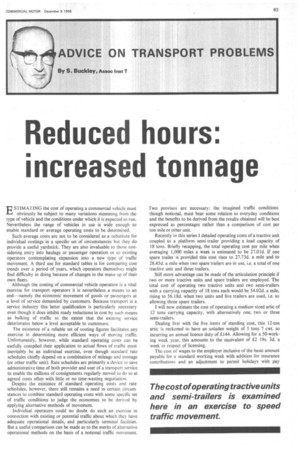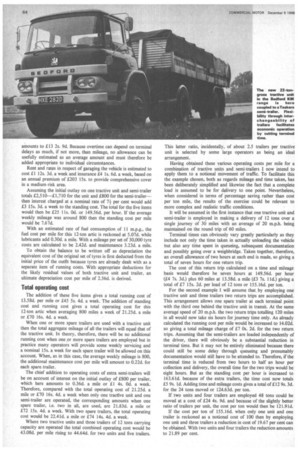Reduced hours: increased tonnage
Page 65

Page 66

If you've noticed an error in this article please click here to report it so we can fix it.
ESTIMATING the cost of operating a commercial vehicle must obviously be subject to many variations stemming from the type of vehicle and the conditions under which it is expected to run. Nevertheless the range of vehicles in use is wide enough to enable standard or average operating costs to be determined.
Such average costs are not to be considered as a substitute for individual costings in a specific set of circumstances but they do provide a useful yardstick. They are also invaluable to those considering entry into haulage or passenger operation or to existing operators contemplating expansion into a new type of traffic movement. A third use for standard tables is for comparing cost trends over a period of years, which operators themselves might find difficulty in doing because of changes in the make-up of their own fleets.
Although the costing of commercial vehicle operation is a vital exercise for transport operators it is nevertheless a means to an end—namely the economic movement of goods or passengers at a level of service demanded by customers. Because transport is a service industry this latter qualification is particularly necessary even though it does inhibit ready reductions in cost by such means as bulking of traffic to the extent that the existing service deteriorates below a level acceptable to customers.
The existence of a reliable set of costing figures facilitates any exercise in determining more efficient ways of moving traffic. Unfortunately, however, while standard operating costs can be usefully compiled their application to actual flows of traffic must inevitably be an individual exercise, even though standard rate schedules chiefly depend on a combination of mileage and tonnage (or other traffic unit). Rate schedules are primarily a device to save administrative time of both provider and user of a transport service to enable the millions of consignments regularly moved to do so at agreed costs often with little or no time-wasting negotiation.
Despite the existence of standard operating costs and rate schedules, however, there still remains a need in certain circumstances to combine standard operating costs with some specific set of traffic conditions to judge the economies to be derived by applying alternative methods of movement.
Individual operators could no doubt do such an exercise in connection with existing or potential traffic about which they have adequate operational details, and particularly terminal facilities. But a useful comparison can be made as to the merits of alternative operational methods on the basis of a notional traffic movement. Two provisos are necessary: the imagined traffic conditions though notional, must bear some relation to everyday conditions and the benefits to be derived from the results obtained will be best expressed as percentages rather than a comparison of cost per ton mile or other unit.
Recently in this series I detailed operating costs of a tractive unit coupled to a platform semi-trailer providing a load capacity of 18 tons. Briefly recapping, the total operating cost per, mile when averaging 1,000 miles a week is estimated to be 27.01d. If one spare trailer is provided this cost rises to 27.73d. a mile and to 28.45d. a mile when two spare trailers are in use, i.e. a total of one tractive unit and three trailers.
Still more advantage can be made of the articulation principle if two or more tractive units and spare trailers are employed. The total cost of operating two tractive units and two semi-trailers with a carrying capacity of 18 tons each would be 54.02d. a mile, rising to 56.18d. when two units and five trailers are used, i.e. so allowing three spare trailers.
I will now estimate the cost of operating a medium-sized attic of 12 tons carrying capacity, with alternatively one, two or three semi-trailers.
Dealing first with the five items of standing cost, this 12-ton artic is reckoned to have an unladen weight of 5 tons 7 cwt. so incurring an annual licence duty of £144. Allowing for a 50-working week year, this amounts to the equivalent of £2 19s. 3d. a week in respect of licensing.
The cost of wages to the employer inclusive of the basic amount payable for a standard working week with addition for insurance contributions and an adjustment to permit holidays with pay amounts to £13 2s. 9d. Because overtime can depend on terminal delays as much, if not more, than mileage, no allowance can be usefully estimated as an average amount and must therefore be added appropriate to individual circumstances.
Rent and rates in respect of garaging the vehicle is estimated to cost £1 12s. 3d. a week and insurance £4 Is. 6d. a week, based on an annual premium of £203 15s. to provide comprehensive cover in a medium-risk area.
Assuming the initial outlay on one tractive unit and semi-trailer totals £2,510-11,710 for the unit and £800 for the semi-trailer-then interest charged at a nominal rate of 7+ per cent would add £3 15s. 3d. a week to the standing cost. The total for the five items would then be £25 Ils. Od. or 149.56d. per hour. If the average weekly mileage was around 800 then the standing cost per mile would be 7.67d.
With an estimated rate of fuel consumption of 11 m.p.g., the fuel cost per mile for this 12-ton artic is reckoned at 5.07d. while lubricants add 0.30d. a mile. With a mileage per set of 30,000 tyre costs are calculated to be 2.42d. and maintenance 3.23d. a mile.
To obtain the balance to be written off as depreciation the equivalent cost of the original set of tyres is first deducted from the initial price of the outfit because tyres are already dealt with as a separate item of running costs. With appropriate deductions for the likely residual values of both tractive unit and trailer, an ultimate depreciation cost per mile of 2.56d. is derived.
Total operating cost The addition of these five items gives a total running cost of 13.58d. per mile or £45 5s. 4d. a week. The addition of standing cost and running cost gives a total operating cost for this 12-ton artic when averaging 800 miles a week of 21.25d. a mile or £70 16s. 4d. a week.
When one or more spare trailers are used with a tractive unit then the total aggregate mileage of all the trailers will equal that of the tractive unit. In theory, therefore, there will be no additional running cost when one or more spare trailers are employed but in practice many operators will provide some weekly servicing and a nominal 15s. a week for each spare trailer will be allowed on this account. When, as in this case, the average weekly mileage is 800, the additional maintenance cost per mile will amount to 0.22d. for each spare trailer.
The chief addition to operating costs of extra semi-trailers will be on account of interest on the initial outlay of £800 per trailer, which here amounts to 0.36d. a mile or £1 4s. Od. a week. Therefore, compared with the total operating cost of 21.25d. a mile or £70 16s. 4d. a week when only one tractive unit and one semi-trailer are operated, the corresponding amounts when one spare trailer, i.e. two in all, are used, are 21.83d. a mile or £72 15s. 4d. a week. With two spare trailers, the total operating cost would be 22.41d. a mile or £74 14s. 4d. a week.
Where two tractive units and three trailers of 12 tons carrying capacity are operated the total combined operating cost would be 43.08d. per mile rising to 44.64d. for two units and five trailers. This latter ratio, incidentally, of about 2.5 trailers per tractive unit is selected by some large operators as being an ideal arrangement.
Having obtained these various operating costs per mile for a combination of tractive units and semi-trailers I now intend to apply them to a notional movement of traffic. To facilitate this the example chosen, both as regards mileage and time taken, has been deliberately simplified and likewise the fact that a complete load is assumed to be for delivery to one point. Nevertheless, when considered in terms of percentage saving rather than cost per ton mile, the results of the exercise could be relevant to more complex and realistic traffic conditions.
It will be assumed in the first instance that one tractive unit and semi-trailer is employed in making a delivery of 12 tons over a single journey of 30 miles with an average of 20 m.p.h. being maintained on the round trip of 60 miles.
Terminal times can obviously vary greatly particularly as they include not only the time taken in actually unloading the vehicle but also any time spent in queueing, subsequent documentation and possibly going over a weighbridge. Taken together, therefore, an overall allowance of two hours at each end is made, so giving a total of seven hours for one return trip.
The cost of this return trip calculated on a time and mileage basis would therefore be seven hours at 149.56d. per hour (£4 7s. 3d.) plus 60 miles at 13.58d. a mile (£3 7s. I Id.) giving a total of £7 15s. 2d. per load of 12 tons or 155.16d. per ton.
For the second example I will assume that by employing one tractive unit and three trailers two return trips are accomplished. This arrangement allows one spare trailer at each terminal point with the third one behind the tractive unit in transit. At the same average speed of 20 m.p.h. the two return trips totalling 120 miles in all would now take six hours for journey time only. As already calculated the running cost per mile would be increased to 14.02d. so giving a total mileage charge of £7 Os. 2d. for the two return trips. Assuming that the semi-trailers are loaded independently of the driver, there will obviously be a substantial reduction in terminal time. But it may not be entirely eliminated because there could still be some delay through queueing and presumably documentation would still have to be attended to. Therefore, if the terminal time is reduced from two hours to half an hour per collection and delivery, the overall time for the two trips would be eight hours. But as the standing cost per hour is increased to 163.61d. because of the extra trailers, the time cost now totals £5 9s. Id. Adding time and mileage costs gives a total of £12 9s. 3d. for the 24 tons moved or 124.63d. per ton.
If two units and four trailers are employed 48 tons could be moved at a cost of £24 4s. 9d. and because of the slightly better ratio of trailers per unit, the cost per ton would then be 121.91d.
If the cost per ton of 155.16d. when only one unit and one trailer is reckoned as a notional cost of 100 then by employing one unit and three trailers a reduction in cost of 19.67 per cent can be obtained. With two units and four trailers the reduction amounts to 21.89 per cent.












































































































